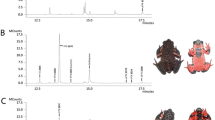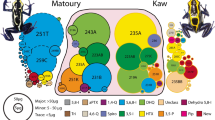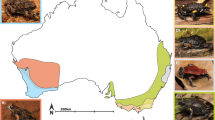Abstract
Brightly colored Malagasy poison frogs, Mantella spp., sequester lipophilic, basic alkaloids from arthropod prey for their own chemical defense. Consequently, microsympatric prey diversity is expected to influence alkaloid diversity observed in poison frogs. Twenty-two specimens of three Mantella species from four localities in moist forests of southeastern Madagascar were analyzed individually via gas chromatography-mass spectrometry, revealing that they contain over 80 known alkaloids. Frogs within a locality possessed significantly similar alkaloid content and diversity, while frogs from areas that varied in disturbance, elevation, and/or species showed greater differences. Based on dietary data, the larger frog species Mantella baroni consumed more and larger prey, and showed greater diversity in skin alkaloids than significantly smaller Mantella bernhardi. Additionally, frogs from the most pristine locality had the greatest number of alkaloids, whereas individuals from the most disturbed localities had the least. In a comparison of frog alkaloid profiles over a 10- to 14-yr period, alkaloid turnover, and thus presumably alkaloid-source arthropod turnover, was high in a disturbed locality and low in the pristine primary forest locality. We demonstrate that the nonlethal transcutaneous amphibian stimulator (TAS) is effective for harvesting alkaloids from poison frogs; future studies using this device could obtain larger sample sizes without harming local frog populations.


Similar content being viewed by others
Abbreviations
- TAS:
-
transcutaneous amphibian stimulator
- Ampa:
-
Ampasimpotsy
- Vato:
-
Vatoharanana
- Saha:
-
Sahavondrona
- Vohi:
-
Vohiparara
- AMNH:
-
American Museum of Natural History
- UADAB:
-
University of Antananarivo Department of Animal Biology
- RA:
-
relative abundance in EI mode
- SVL:
-
snout–vent length
References
Bradt, H. 1999. Madagascar, the Bradt Travel Guide. Globe Pequot Press, USA.
Clark, V. C., Raxworthy, C. J., Rakotomalala, V., Sierwald, P., and Fisher, B. L. 2005. Convergent evolution of chemical defense in poison frogs and arthropod prey between Madagascar and the Neotropics. Proc. Natl. Acad. Sci. USA 102:11617–11622.
Daly, J. W. 1982. Alkaloids of Neotropical poison frogs (Dendrobatidae). Fortschr. Chem. Org. Naturst. (Prog. Chem. Org. Natl. Prod.) 41:205–340.
Daly, J. W. 2005. Nicotinic agonists, antagonists, and modulators from natural sources. Cell. Mol. Neurobiol. 25:513–552.
Daly, J. W., Garraffo, H. M., Pannell, L. K., Spande, T. F., Severini, C., and Erspamer, V. 1990. Alkaloids from Australian frogs (Myobatrachidae): pseudophyrnamines and pumiliotoxins. J. Nat. Prod. 53:401–21.
Daly, J. W., Secunda, S. I., Garraffo, H. M., Spande, T. F., Wisneiski, A., Nishihira, C., and Cover, J. F. Jr. 1992. Variability in alkaloid profiles in Neotropical poison frogs (Dendrobatidae): Genetic versus environmental determinants. Toxicon 30:887–98.
Daly, J. W., Garraffo, H. M., Spande, T. F., Jaramillo, C., and Rand, A. S. 1994a. Dietary source for skin alkaloids of poison frogs (Dendrobatidae)? J. Chem. Ecol. 20:943–55.
Daly, J. W., Secunda, S. I., Garraffo, H. M., Spande, T. F., Wisnieski, A., and Cover, J. F. Jr. 1994b. An uptake system for dietary alkaloids in poison frogs (Dendrobatidae). Toxicon 32:657–63.
Daly, J. W., Andriamaharavo, N. R., Andriantsiferana, M., and Myers, C. W. 1996. Madagascan poison frogs (Mantella) and their skin alkaloids. Am. Mus. Novit. 3177:1–34.
Daly, J. W., Garraffo, H. M., Hall, G. S., and Cover, J. F. Jr. 1997. Absence of skin alkaloids in captive-raised Madagascan mantelline frogs (Mantella) and sequestration of dietary alkaloids. Toxicon 35:1131–5.
Daly, J. W., Garraffo, H. M., and Spande, T. F. 1999. Alkaloids from amphibian skins, pp. 1–161, in S. W. Pelletier (ed.). Alkaloids: Chemical and Biological Perspectives, vol. 13. Pergamon, New York.
Daly, J. W., Kaneko, T. Wilham, J. Garraffo, H. M. Spande, T. F. Espinosa A., and Donnelly, M. A. 2002. Bioactive alkaloids of frog skin: combinatorial bioprospecting reveals that pumiliotoxins have an arthropod source. Proc. Natl. Acad. Sci. USA. 99:13996–14001.
Daly, J. W., Garraffo, H. M., Spande, T. F., Clark, V. C., Ma, J., Ziffer, H., and Cover, J. F. Jr. 2003. Evidence for an enantioselective pumiliotoxin 7-hydroxylase in dendrobatid poison frogs of the genus Dendrobates. Proc. Natl. Acad. Sci. USA 100:11092–7.
Daly, J. W., Noimai, N., Kongkathip, B., Kongkathip, N., Wilham, J., Garraffo, H. M., Kaneko, T., Spande, T. F., Nimit, Y., Nabhitabhata, J., and Chan-Ard, T. 2004. Biologically active substances from amphibians: preliminary studies on anurans from twenty-one genera of Thailand. Toxicon 44:805–15.
Daly, J. W., Spande, T. F., and Garraffo, H. M. 2005. Alkaloids from amphibian skin: a tabulation of over eight-hundred compounds. J. Nat. Prod. 68:1556–1575.
Eisner, T., Alsop, D., Hicks, K., and Meinwald, J. 1978. Defensive secretions of millipeds. In S. Bettini (ed.). Handbook of Experimental Pharmacology, vol. 48, Arthropod Venoms. Springer-Verlag, New York.
Fisher, B. 1998. Ant diversity patterns along an elevational gradient in the Reserve Speciale d’Anjanaharibe-Sud and on the Western Masoala Peninsula, Madagascar. Fieldiana, Zool. 90:39–67.
Fisher, B. L., Ratsirarson, H., and Razafimandimby, S. 1998. Les Fourmis (Hymenoptera: Formicidae) pp. 107–131. In: Inventaire biologique de la Forêt Littorale de Tampolo (Fenoarivo Atsinaanana). J. Ratsirarson and S.M. Goodman (eds.). Recherches pour le Développement, Série Sciences Biologiques. No. 14. Centre d’Information et de Documentation Scientifique et Technique, Antananarivo, Madagascar.
Fisher, B. L. 2005. A new species of Discothyrea Roger from Mauritius and a new species of Proceratium from Madagascar (Hymenoptera: Formicidae). Proc. Calif. Acad. Sci. 56:657–667.
Grant, J. B. and Land, B. 2002. Transcutaneous Amphibian Stimulator (TAS): a device for the collection of amphibian skin secretions. Herpetol. Rev. 33:38–41.
Jones, T. H., Gorman, J. S., Snelling, R. R., Delabie, J. H., Blum, M. S., Garraffo, H. M., Jain, P., Daly, J. W., and Spande, T. F. 1999. Further alkaloids common to ants and frogs: decahydroquinolines and a quinolizidine. J. Chem. Ecol. 25:1179–93.
King, A. G. and Meinwald, J. 1996. Review of the defensive chemistry of Coccinellids. Chem. Rev. 96:1105–22.
Laurent, P., Braekman, J. C., and Daloze, D. 2005. Insect chemical defense. Top. Curr. Chem. 240:167–229.
Leclercq, S., Braekman, J. C., Daloze, D., and Pasteels, J. M. 2000. The defensive chemistry of ants. Prog. Chem. Org. Nat. Prod. 79:115–229.
Mebs, D., Pogoda, W., Maneyro, R., and Kwet, A. 2005. Studies on the poisonous skin secretion of individual red bellied toads, Melanophyrniscus montevidensis (Anura, Bufonidae), from Uruguay. Toxicon 46:641–650.
Myers, C. W. and Daly, J. W. 1980. Taxonomy and ecology of Dendrobates bombetes, a new Andean poison frog with new skin toxins. Am. Mus. Novit. 2692:1–23.
Myers, C. W., Daly, J. W., Garraffo, H. M., Wisnieski, A., and Cover, J. F. Jr. 1995. Discovery of the Costa Rican poison frog Dendrobates granuliferus in sympatry with Dendrobates pumilio, and comments on taxonomic use of skin alkaloids. Am. Mus. Novit. 3144:1–21.
Rabemananjara, F., Bora, P., Cadle, J. E., Anderone, F., Rajeriarison, E., Talata, P., Glaw, F., Vences, M., and Vietes, D. R. 2005. New records, distribution and conservation of Mantella bernhardi, an endangered frog species from south-eastern Madagascar. Oryx 39:339–342.
Saporito, R. A., Garraffo, H. M., Donnelly, M. A., Edwards, A. L., Longino, J. T., and Daly, J. W. 2004. Formicine ants: an arthropod source for the pumiliotoxin alkaloids of dendrobatid poison frogs. Proc. Natl. Acad. Sci. USA 101:8045–50.
Saporito, R. A., Donnelly, M. A., Garraffo, H. M., Spande, T. F. and Daly, J. W. 2006. Geographic and seasonal variation in alkaloid-based chemical defenses of Dendrobates pumilio from Bocas del Toro, Panama. J. Chem. Ecol. DOI http://dx.doi.org/10.1007/s10886-006-9034.
Smith, B. P., Tyler, M. J., Kaneko, T., Garraffo, H. M., Spande, T. F., and Daly, J. W. 2002. Evidence for biosynthesis of pseudophrynamine alklaloids by an Australian Myobatrachid frog (Pseudophryne) and for the sequestration of dietary pumiliotoxins. J. Nat. Prod. 65:439–47.
Takada, W., Sakata, T., Shimano, S., Enami, Y., Mori, N., Nishida, R., and Kuwahara, Y. 2005. Scheloribatid mites as the source of pumiliotoxins in dendrobatid frogs. J. Chem. Ecol. 31:2403–2415.
Vences, M., Glaw, F., and Bohme, W. 1999. A review of the genus Mantella (Anura, Ranidae, Mantellinae): taxonomy, distribution and conservation of Malagasy poison frogs. Alytes 17:3–72.
Acknowledgments
We thank Elizabeth E., Sandra P., and William S. Clark, John W. Daly, Jerrold Meinwald, Helian Ratsirarson, Aimee Razafiarimalala, and Justin Solo for their help, anonymous reviewers for critical readings of this manuscript, Christopher J. Raxworthy for discussions, Julián Faivovich for frog dissection training, and Florio Arguillas and Françoise Vermeylen for statistical consulting at Cornell. This work was supported by National Science Foundation Grants DEB-9984496 (to C.J. Raxworthy) for VC Clark’s 2003 fieldwork, DEB-0344731 (to B.L.F. and P.S. Ward) for arthropod processing, and CHE-0216226 to Prof. Koji Nakanishi for GC-TOF-MS acquisition and partial support of L.A. The UADAB, Association Nationale pour la Gestion des Aires Protégées, Direction Generale des Eaux et Forêts, Madagascar Institute pour la Conservation des Ecosystèmes Tropicaux, and California Academy of Sciences team in Antananarivo facilitated activities in Madagascar, and Columbia University (including Edward Bass for Biosphere 2) and the American Museum of Natural History provided research support in the United States.
Author information
Authors and Affiliations
Corresponding author
Electronic supplementary material
Below is the link to the electronic supplementary material.
Supplement 1
Supplementary information for journal of chemical ecology (PDF 494 kb)
Rights and permissions
About this article
Cite this article
Clark, V.C., Rakotomalala, V., Ramilijaona, O. et al. Individual Variation in Alkaloid Content of Poison Frogs of Madagascar (Mantella; Mantellidae). J Chem Ecol 32, 2219–2233 (2006). https://doi.org/10.1007/s10886-006-9144-6
Published:
Issue Date:
DOI: https://doi.org/10.1007/s10886-006-9144-6




